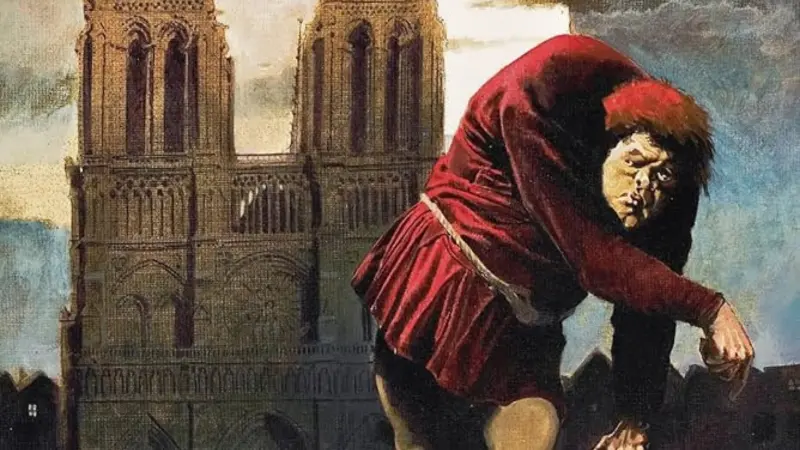The book that has captivated me these past few months, which I had to savor slowly due to my extremely poor eyesight, is “Notre Dame De Paris” by Victor Hugo.
Having never seen any other representation, I am compelled to compare it to the only other version “inspired” by the story, namely Disney’s “The Hunchback of Notre Dame.” To say that the animated work inspired by Hugo’s masterpiece is, as always, a distortion of almost all the moral and social lessons contained in the original work is almost an understatement of the distortion itself.
It is truly interesting to see how, under the pretext of making adaptations more suitable for children and young people, most of the lessons are always destroyed… but I realize I have already gone too far, so let’s take a step back and talk about the original literary work.
NOTRE DAME DE PARIS

“Notre Dame De Paris” is, in its essence, like old honey: thick, spicy, tempting but difficult to swallow, and in its style and story, it feels sweet but leaves a decidedly bitter aftertaste.
Hugo definitely takes his time with the narration, with a story that has a decidedly unhurried pace and many interruptions that break it up even more.
So it happens that the beginning deals with something we definitely do not expect, namely the description of the Parisian crowd during the Feast of Fools, for pages and pages, making us believe that perhaps we have the wrong novel, causing a desire to skip pages to get to the “heart,” the truly important events which, when they arrive, feel like a liberation and glue our eyes to the pages as a film could not do with the screen.
And then, when the story seems to have reached a key point… it stops to spend the next chapters describing nothing but the Notre Dame Cathedral and Paris itself, using dozens of pages that almost completely forget the original narration to devote themselves to an ode to the city and its beauties.
So on and on until the end of a tale that, in its rawness, truly leaves a bitter taste but makes one reflect on many things.
“Notre Dame De Paris,” in fact, despite being presented as a love story, is everything but a tale where we can find love: within it, we find the representation of everything that is NOT love, starting from the carnal obsession of the priest, the pure lust of the soldier, the near idolatry of Quasimodo, and the superficial idealization of Esmeralda.
Yes, because the main difference between the original story and the animated representation inspired by it is that the original story clearly aims to destroy every form of moral preconception related to love and, above all, to institutions.
So we discover that what in the animated series is an inquisitor, in the original story is instead a priest. A priest corroded to his core by a purely carnal desire for a barely 16-year-old Esmeralda, a girl with a good heart but extremely superficial and, in her own way, foolish, but we will talk more about this later.
We also discover that the good soul of the animated story, namely the captain of the guards whom Esmeralda falls in love with, is anything but an honorable person who, with the sole aim of adding another notch to his belt, deceives the poor 16-year-old girl into giving him a night of something we certainly cannot call love, lying, and the book takes care to specify this, like many other times, when talking about love and marriage.
We face a Quasimodo who, much more realistically, is not only deformed but also deaf and much more servile and “depressed” than the animation suggests, constantly self-flagellating for his ugliness, becoming an invisible servant to the person who showed him a glimmer of sweetness, even if she addresses him with harsh words on more than one occasion, even killing dozens of people to save her.
Then we face a character, Gringoire, who in his simplicity is perhaps the best (and indeed he does not exist in the animated work) and who, as soon as he sees the opportunity, abandons the entire drama and escapes with Esmeralda’s goat, the only truly loving being in the whole story.
We then conclude with the star, Esmeralda, the 16-year-old gypsy who, in her good-heartedness, gets lost in the illusions and foolishness of her age, falling in love with an unworthy person like Captain Phoebus just because he is “as beautiful as the sun” and “brave,” eventually giving up her life just to shout his name one last time while the entire inquisition is on her trail for witchcraft.
An honorable mention in the story goes to the representation of the people of Paris who, as a populace, prove to be extremely manipulable, allowing themselves to be swept along by events to the point of celebrating Quasimodo one day and imprisoning him in the stocks the next, turning away while a true guerrilla war erupts in the streets, only to take a “courageous” interest upon the arrival of the armed forces, being enchanted by Esmeralda’s dances one day, and gathering en masse to witness her execution in the public square the next.
I don’t want to reveal more, in case someone has not yet had the pleasure of getting lost in the paragraphs of the story, but I think it is important to highlight how Victor Hugo, in his original work, dismantles all the positive preconceptions tied to various stereotypes, giving instead a raw and real representation.
Thus we have the sanctity of the priest turned into demonic corruption of the soul itself, which ultimately leads to the death of the object of desire, himself, his brother, and the faithful Quasimodo.
Thus we have the handsome and brave captain of the guards, a symbol of virtue, reduced to the much more human role of a narcissist and womanizer, willing to lie in any way to warm himself at night with the beautiful body of a young girl, to the point of turning and walking away with his fiancée while the poor Esmeralda is on the scaffold, condemned to death for his own murder.
We have kings and law enforcement who let the people devastate the city of Paris when they think the goal is to eliminate a “particularly inconvenient” character to the king himself, only to intervene when they begin to think that the people’s goal is “the king’s character himself.”
A story, as I mentioned before, that talks about everything that is not love, highlighting the worst of the human soul, the grave damages that can be caused by a lack of communication, and warning against making superficial judgments based only on appearance and social status of a person.
All things that, of course, in the animated series were destroyed in such a way as to, in fact, reinforce the illusion that “the handsome,” as well as part of the law enforcement, is someone to rely on, that the priest as a man of the church cannot be bad (in fact, he is not made a priest, but an inquisitor), and so on… in a work that destroys the most important content within the original work as a life lesson and warning.
A story that is really worth reading in its entirety, reflecting on it as much as possible.
We could learn very important lessons on how to view the world and the people who inhabit it.
Luca




